Impacts of Land Use Intensity on Ecosystem Services: A Case Study in Harbin City, China
Abstract
:1. Introduction
2. Materials and Methods
2.1. Overview of the Study Area
2.2. Data Sources
2.3. Land Use Intensity Assessment
2.4. ESs Assessment
2.4.1. Food Supply
2.4.2. Water Conservation
2.4.3. Soil Conservation
2.4.4. Carbon Stocks
2.4.5. Water Purification
2.4.6. Habitat Quality
2.5. Statistical Analyses
2.5.1. Hotspot Delineation
2.5.2. Spearman’s Correlation Analysis
2.5.3. Identification of ES Bundles
2.6. Bivariate Spatial Autocorrelation
3. Results
3.1. Changes in LUI during 2000–2020
3.2. Changes in ESs during 2000–2020
3.3. Spearman’s Correlation Analysis
3.4. Identification of ES Hotspots
3.5. Spatial–Temporal Patterns of ES Bundles
3.6. Impacts of LUI Changes on ESs
4. Discussion
4.1. Spatial Pattern and Evolution Characteristics in LUI and ESs
4.2. Impact of LUI on ESs
4.3. Policy Implications
5. Conclusions
- (1)
- The main land uses in Harbin were agricultural land and forest, with the area of agricultural land continuing to decrease. The area of forest and wetland showed a trend of decreasing and then increasing, the area of grassland increased and then decreased, and the area of water bodies, construction land, and bare land continued to increase. The overall LUI showed a spatial distribution pattern of “high in the west and low in the east”, and during the period of 2000–2020, land use in Harbin City experienced a more drastic change, with the overall LUI showing a trend of decreasing and then increasing.
- (2)
- Except for FP, all other ESs showed a similar spatial distribution pattern of “low west and high east”, with WC showing a continuous and significant increase. WC showed a continuous increase, and the increase was very significant. Nitrogen export intensity decreased slightly, so WP showed a slight upward trend, while SC showed a decreasing and then an increasing trend and CS and HQ were generally stable, with little change. Based on the dominant ecosystem service types, Harbin City can be categorized into five ecosystem service bundles.
- (3)
- There is a significant positive correlation between LUI and FP and a significant negative correlation with other ESs. “High LUI-High FP” is mainly located in the western part of the city. “Low LUI-High WC”, “Low LUI-High SC”, “Low LUI-High CS”, and “Low LUI-High HQ” were mainly concentrated in the ecological barrier areas of Xiaoxing’an Mountains and Zhangguangcai Range.
Author Contributions
Funding
Institutional Review Board Statement
Informed Consent Statement
Data Availability Statement
Conflicts of Interest
References
- Costanza, R.; D’Arge, R.; de Groot, R.; Farber, S.; Grasso, M.; Hannon, B.; Limburg, K.; Naeem, S.; O’Neill, R.V.; Paruelo, J.; et al. The value of the world’s ecosystem services and natural capital. Nature 1997, 387, 253–260. [Google Scholar] [CrossRef]
- Haberl, H.; Wackernagel, M.; Wrbka, T. Land use and sustainability indicators. An introduction. Land Use Policy 2004, 21, 193–198. [Google Scholar] [CrossRef]
- Mooney, H.; Duraiappah, A.; Larigauderie, A. Evolution of natural and social science interactions in global change research programs. Proc. Natl. Acad. Sci. USA 2013, 110, 3665–3672. [Google Scholar] [CrossRef]
- Wang, Y.; Zhao, J.; Fu, J.; Wei, W. Quantitative assessment of water conservation function and spatial pattern in Shiyang River basin. Acta Ecol. Sin. 2018, 38, 4637–4648. [Google Scholar]
- Liu, Y.; Zhao, W.; Jia, L. Soil conservation service: Concept, assessment, and outlook. Acta Ecol. Sin. 2019, 39, 432–440. [Google Scholar]
- Terrado, M.; Acuña, V.; Ennaanay, D.; Tallis, H.; Sabater, S. Impact of climate extremes on hydrological ecosystem services in a heavily humanized Mediterranean basin. Ecol. Indic. 2014, 37, 199–209. [Google Scholar] [CrossRef]
- Guo, J.; Jiang, C.; Wang, Y.; Yang, J.; Huang, W.; Gong, Q.; Zhao, Y.; Yang, Z.; Chen, W.; Ren, H. Exploring ecosystem responses to coastal exploitation and identifying their spatial determinants: Re-orienting ecosystem conservation strategies for landscape management. Ecol. Indic. 2022, 138, 108860. [Google Scholar] [CrossRef]
- Wang, P.; Wang, J.; Zhang, J.; Ma, X.; Zhou, L.; Sun, Y. Spatial-temporal changes in ecosystem services and social-ecological drivers in a typical coastal tourism city: A case study of Sanya, China. Ecol. Indic. 2022, 145, 109607. [Google Scholar] [CrossRef]
- Bai, Y.; Zheng, H.; Ouyang, Z.; Zhuang, C.; Jiang, B. Modeling hydrological ecosystem services and tradeoffs: A case study in Baiyangdian watershed, China. Environ. Earth Sci. 2013, 70, 709–718. [Google Scholar] [CrossRef]
- Li, J.; Xie, B.; Gao, C.; Zhou, K.; Liu, C.; Zhao, W.; Xiao, J.; Xie, J. Impacts of natural and human factors on water-related ecosystem services in the Dongting Lake Basin. J. Clean. Prod. 2022, 370, 133400. [Google Scholar] [CrossRef]
- Sample, J.E.; Baber, I.; Badger, R. A spatially distributed risk screening tool to assess climate and land use change impacts on water-related ecosystem services. Environ. Modell. Softw. 2016, 83, 12–26. [Google Scholar] [CrossRef]
- Vihervaara, P.; Rönkä, M.; Walls, M. Trends in ecosystem service research: Early steps and current drivers. Ambio 2010, 39, 314–324. [Google Scholar] [CrossRef] [PubMed]
- Xia, H.; Yuan, S.; Prishchepov, A.V. Spatial-temporal heterogeneity of ecosystem service interactions and their social-ecological drivers: Implications for spatial planning and management. Resour. Conserv. Recycl. 2023, 189, 106767. [Google Scholar] [CrossRef]
- Verhagen, W.; Van Teeffelen, A.J.A.; Baggio Compagnucci, A.; Poggio, L.; Gimona, A.; Verburg, P.H. Effects of landscape configuration on mapping ecosystem service capacity: A review of evidence and a case study in Scotland. Landsc. Ecol. 2016, 31, 1457–1479. [Google Scholar] [CrossRef]
- Liu, L.; Liu, H.; Ren, J.; Bian, Z.; Ding, S. Research progress on the mechanism of ecosystem services generation. Chin. J. Appl. Ecol. 2017, 28, 2731–2738. [Google Scholar]
- Zeng, Z.; Yang, H.; Ning, Q.; Tang, H. Temporal and spatial evolution of land use intensity and its impact on ecosystem services in Dongting Lake Zone. Econ. Geogr. 2022, 42, 176–185. [Google Scholar]
- Felipe-Lucia, M.; Com, N.F.; Bennett, E. Interactions among ecosystem services across land uses in a floodplain agroecosystem. Ecol. Soc. 2014, 19, 360–375. [Google Scholar] [CrossRef]
- Kindu, M.; Schneider, T.; Teketay, D.; Knoke, T. Changes of ecosystem service values in response to land use/land cover dynamics in Munessa–Shashemene landscape of the Ethiopian highlands. Sci. Total Environ. 2016, 547, 137–147. [Google Scholar] [CrossRef] [PubMed]
- Allan, E.; Manning, P.; Alt, F.; Binkenstein, J.; Blaser, S.; Grassein, F.; Klaus, V.; Kleinebecker, T.; Morris, E.; Oelmann, Y.; et al. Land use intensification alters ecosystem multifunctionality via loss of biodiversity and changes to functional composition. Ecol. Lett. 2015, 18, 834–843. [Google Scholar] [CrossRef] [PubMed]
- Xu, C.; Pu, L.; Zhu, M.; Li, J.; Chen, X.; Wang, X.; Xie, X. Ecological security and ecosystem services in response to land use change in the coastal area of Jiangsu, China. Sustainability 2016, 8, 816. [Google Scholar] [CrossRef]
- Li, J.; Dong, S.; Li, Y.; Wang, Y.; Li, Z.; Li, F. Effects of land use change on ecosystem services in the China–Mongolia–Russia economic corridor. J. Clean. Prod. 2022, 360, 132175. [Google Scholar] [CrossRef]
- Xin, X.; Zhang, T.; He, F.; Zhang, W.; Chen, K. Assessing and simulating changes in ecosystem service value based on land use/cover change in coastal cities: A case study of Shanghai, China. Ocean Coast. Manag. 2023, 239, 106591. [Google Scholar] [CrossRef]
- Cai, Y.; Zhang, P.; Wang, Q.; Wu, Y.; Ding, Y.; Nabi, M.; Fu, C.; Wang, H.; Wang, Q. How does water diversion affect land use change and ecosystem service: A case study of Baiyangdian wetland, China. J. Environ. Manag. 2023, 344, 118558. [Google Scholar] [CrossRef]
- Wang, Z.; Liu, S.; Li, J.; Pan, C.; Wu, J.; Ran, J.; Su, Y. Remarkable improvement of ecosystem service values promoted by land use/land cover changes on the Yungui Plateau of China during 2001–2020. Ecol. Indic. 2022, 142, 109303. [Google Scholar] [CrossRef]
- Li, H.; Ye, C.; Hua, J. Impact of land use change on ecosystem service value in Nanchang City. Res. Soil Water Conserv. 2020, 27, 277–285, 293. [Google Scholar] [CrossRef]
- Xia, H.; Kong, W.; Zhou, G.; Sun, O.J. Impacts of landscape patterns on water-related ecosystem services under natural restoration in Liaohe River Reserve, China. Sci. Total Environ. 2021, 792, 148290. [Google Scholar] [CrossRef]
- Vigerstol, K.L.; Aukema, J.E. A comparison of tools for modeling freshwater ecosystem services. J. Environ. Manag. 2011, 92, 2403–2409. [Google Scholar] [CrossRef]
- Bai, Y.; Ochuodho, T.O.; Yang, J. Impact of land use and climate change on water-related ecosystem services in Kentucky, USA. Ecol. Indic. 2019, 102, 51–64. [Google Scholar] [CrossRef]
- Yohannes, H.; Soromessa, T.; Argaw, M.; Warkineh, B. Spatio-temporal changes in ecosystem service bundles and hotspots in Beressa watershed of the Ethiopian highlands: Implications for landscape management. Environ. Chall. 2021, 5, 100324. [Google Scholar] [CrossRef]
- Yohannes, H.; Soromessa, T.; Argaw, M.; Dewan, A. Impact of landscape pattern changes on hydrological ecosystem services in the Beressa watershed of the Blue Nile Basin in Ethiopia. Sci. Total Environ. 2021, 793, 148559. [Google Scholar] [CrossRef]
- Wang, Y.; Dai, E. Spatial-temporal changes in ecosystem services and the trade-off relationship in mountain regions: A case study of Hengduan Mountain region in Southwest China. J. Clean. Prod. 2020, 264, 121573. [Google Scholar] [CrossRef]
- Liu, W.; Zhan, J.; Zhao, F.; Wang, C.; Zhang, F.; Teng, Y.; Chu, X.; Kumi, M.A. Spatio-temporal variations of ecosystem services and their drivers in the Pearl River Delta, China. J. Clean. Prod. 2022, 337, 130466. [Google Scholar] [CrossRef]
- Pan, H.; Wang, J.; Du, Z.; Wu, Z.; Zhang, H.; Ma, K. Spatiotemporal evolution of ecosystem services and its potential drivers in coalfields of Shanxi Province, China. Ecol. Indic. 2023, 148, 110109. [Google Scholar] [CrossRef]
- Wei, Q.; Abudureheman, M.; Halike, A.; Yao, K.; Yao, L.; Tang, H.; Tuheti, B. Temporal and spatial variation analysis of habitat quality on the PLUS-InVEST model for Ebinur Lake Basin, China. Ecol. Indic. 2022, 145, 109632. [Google Scholar] [CrossRef]
- Cai, C.; Shang, J. Supply-demand level and development capability of Harbin urban ecosystem. Chin. J. Appl. Ecol. 2009, 20, 163–169. [Google Scholar]
- Jin, H.; Li, S.; Wang, S. Impacts of climatic change on permafrost and cold regions environments in China. Acta Geogr. Sin. 2000, 55, 161–173. [Google Scholar]
- Wang, N.; Zang, S.; Zhang, L. Spatial and temporal variations of spermafrost thickness in Heilongjiang province in recent years. Geogr. Res. 2018, 37, 622–634. [Google Scholar]
- Yang, Y.; Meng, X. Study on emission characteristics of agricultural non-point source pollution in Heilongjiang. Ecol. Econ. 2018, 34, 184–190. [Google Scholar] [CrossRef]
- Xie, L.; Yang, Z.; Cai, J.; Cheng, Z.; Wen, T.; Song, T. Harbin: A rust belt city revival from its strategic position. Cities 2016, 58, 26–38. [Google Scholar] [CrossRef]
- Ma, L.; Li, B.; Liu, Y.; Sun, X.; Fu, D.; Sun, S.; Thapa, S.; Geng, J.; Qi, H.; Zhang, A.; et al. Characterization, sources and risk assessment of PM2.5-bound polycyclic aromatic hydrocarbons (PAHs) and nitrated PAHs (NPAHs) in Harbin, a cold city in Northern China. J. Clean. Prod. 2020, 264, 121673. [Google Scholar] [CrossRef]
- Xiao, L.; Wang, W.; He, X.; Lv, H.; Wei, C.; Zhou, W.; Zhang, B. Urban-rural and temporal differences of woody plants and bird species in Harbin city, northeastern China. Urban For. Urban Green. 2016, 20, 20–31. [Google Scholar] [CrossRef]
- Peng, S.; Ding, Y.; Liu, W.; Li, Z. 1 km monthly temperature and precipitation dataset for China from 1901 to 2017. Earth Syst. Sci. Data 2019, 11, 1931–1946. [Google Scholar] [CrossRef]
- Peng, S.; Ding, Y.; Wen, Z.; Chen, Y.; Cao, Y.; Ren, J. Spatiotemporal change and trend analysis of potential evapotranspiration over the Loess Plateau of China during 2011–2100. Agric. For. Meteorol. 2017, 233, 183–194. [Google Scholar] [CrossRef]
- Zhuang, D.; Liu, J. Study on the model of regional differentiation of land use degee in China. J. Nat. Resour. 1997, 12, 105–111. [Google Scholar]
- Yang, S.; Bai, Y.; Alatalo, J.M.; Wang, H.; Jiang, B.; Liu, G.; Chen, J. Spatio-temporal changes in water-related ecosystem services provision and trade-offs with food production. J. Clean. Prod. 2021, 286, 125316. [Google Scholar] [CrossRef]
- Zhou, W.; Liu, G.; Pan, J.; Feng, X. Distribution of available soil water capacity in China. J. Geogr. Sci. 2005, 15, 3–12. [Google Scholar] [CrossRef]
- He, S.; Zhu, W.; Cui, Y.; He, C.; Ye, L.; Feng, X.; Zhu, L. Study on soil erosion characteristics of Qihe Watershed in Taihang Mountains based on the InVEST model. Resour. Environ. Yangtze Basin 2019, 28, 426–439. [Google Scholar]
- Sheng, M.; Fang, H.; Sun, Y.; Guo, M. Analysis of factors affecting soil erosion and sediment yield at catchments in the black soil region of Northeast China. J. Shaanxi Norm. Univ. Nat. Sci. Ed. 2015, 43, 86–92. [Google Scholar]
- Liu, M.; Zhang, H.; Ren, H.; Pei, H. Spatiotemporal Variations of the Soil Conservation in the Agro-pastoral Ecotone of Northern China Under Grain for Green Program. Res. Soil Water Conserv. 2021, 28, 172–178. [Google Scholar]
- Yan, L.; Gong, J.; Xu, C.; Cao, E.; Li, H.; Gao, B.; Li, Y. Spatiotemporal variations and influencing factors of soil conservation service based on InVEST model: A case study of Miyun Reservoir upstream basin of Zhangcheng area in Hebei. J. Soil Water Conserv. 2021, 35, 188–197. [Google Scholar]
- Tang, X.; Zhao, X.; Bai, Y.; Tang, Z.; Wang, W.; Zhao, Y.; Wan, H.; Xie, Z.; Shi, X.; Wu, B.; et al. Carbon pools in China’s terrestrial ecosystems: New estimates based on an intensive field survey. Proc. Natl. Acad. Sci. USA 2018, 115, 4021–4026. [Google Scholar] [CrossRef] [PubMed]
- Ye, K.; Meng, F.; Zhang, L.; Yao, Z.; Xue, H.; Cheng, P.; Zhang, D. Spatial-temporal variation characteristics and source analysis of nitrogen pollution in the Songhua River Basin. Res. Environ. Sci. 2020, 33, 901–910. [Google Scholar]
- Zheng, L.; Wang, Y.; Li, J. Quantifying the spatial impact of landscape fragmentation on habitat quality: A multi-temporal dimensional comparison between the Yangtze River Economic Belt and Yellow River Basin of China. Land Use Policy 2023, 125, 106463. [Google Scholar] [CrossRef]
- Zhang, X.; Song, W.; Lang, Y.; Feng, X.; Yuan, Q.; Wang, J. Land use changes in the coastal zone of China’s Hebei Province and the corresponding impacts on habitat quality. Land Use Policy 2020, 99, 104957. [Google Scholar] [CrossRef]
- Li, Y.; Zhang, L.; Qiu, J.; Yan, J.; Wan, L.; Wang, P.; Hu, N.; Cheng, W.; Fu, B. Spatially explicit quantification of the interactions among ecosystem services. Landsc. Ecol. 2017, 32, 1181–1199. [Google Scholar] [CrossRef]
- Shen, J.; Li, S.; Liu, L.; Liang, Z.; Wang, Y.; Wang, H.; Wu, S. Uncovering the relationships between ecosystem services and social-ecological drivers at different spatial scales in the Beijing-Tianjin-Hebei region. J. Clean. Prod. 2021, 290, 125193. [Google Scholar] [CrossRef]
- Shen, J.; Li, S.; Liang, Z.; Liu, L.; Li, D.; Wu, S. Exploring the heterogeneity and nonlinearity of trade-offs and synergies among ecosystem services bundles in the Beijing-Tianjin-Hebei urban agglomeration. Ecosyst. Serv. 2020, 43, 101103. [Google Scholar] [CrossRef]
- Zhu, Z.; Alimujiang, K. Analysis and simulation of the spatial autocorrelation pattern in the ecosystem service value of the oasis cities in dry areas. J. Ecol. Rural Environ. 2019, 35, 1531–1540. [Google Scholar]
- Wang, B.; Wang, Y.; Wang, S. Improved water pollution index for determining spatiotemporal water quality dynamics: Case study in the Erdao Songhua River Basin, China. Ecol. Indic. 2021, 129, 107931. [Google Scholar] [CrossRef]
- Li, Q.; Zhang, X.; Liu, Q.; Liu, Y.; Ding, Y.; Zhang, Q. Impact of land use intensity on ecosystem services: An example from the agro-pastoral ecotone of central Inner Mongolia. Sustainability 2017, 9, 1030. [Google Scholar] [CrossRef]
- Zhou, Y.; Gu, G.; Ren, Q.; Yang, J. Research on the relationship between business cycle and industrial fluctuations in northeast China based on complete ensemble empirical mode decomposition with adaptive noise. Complexity 2021, 2021, 8832201. [Google Scholar] [CrossRef]
- Fang, J.; Song, H.; Zhang, Y.; Li, Y.; Liu, J. Climate-dependence of ecosystem services in a nature reserve in northern China. PLoS ONE 2018, 13, e192727. [Google Scholar] [CrossRef] [PubMed]
- Escobar-Ocampo, M.; Castillo-Santiago, M.; Ochoa-Gaona, S.; Enríquez, P.; Sibelet, N. Assessment of habitat quality and landscape connectivity for forest-dependent cracids in the Sierra Madre del Sur Mesoamerican biological corridor, Mexico. Trop. Conserv. Sci. 2019, 12, 324260266. [Google Scholar] [CrossRef]
- Fernández-Alonso, M.J.; Rodríguez, A.; García-Velázquez, L.; Dos Santos, E.; de Almeida, L.; Lafuente, A.; Wang, J.; Singh, B.; Fangueiro, D.; Durán, J. Integrative effects of increasing aridity and biotic cover on soil attributes and functioning in coastal dune ecosystems. Geoderma 2021, 390, 114952. [Google Scholar] [CrossRef]
- Xu, L.; Chen, S.S.; Xu, Y.; Li, G.; Su, W. Impacts of land-use change on habitat quality during 1985–2015 in the Taihu Lake Basin. Sustainability 2019, 11, 3513. [Google Scholar] [CrossRef]
- Zhang, J.; Guo, W.; Cheng, C.; Tang, Z.; Qi, L. Trade-offs and driving factors of multiple ecosystem services and bundles under spatiotemporal changes in the Danjiangkou Basin, China. Ecol. Indic. 2022, 144, 109550. [Google Scholar] [CrossRef]
- Chen, T.; Feng, Z.; Zhao, H.; Wu, K. Identification of ecosystem service bundles and driving factors in Beijing and its surrounding areas. Sci. Total Environ. 2020, 711, 134687. [Google Scholar] [CrossRef] [PubMed]
- He, G.; Wang, S.; Zhang, B. Watering down environmental regulation in China. Q. J. Econ. 2020, 135, 2135–2185. [Google Scholar] [CrossRef]
- Wang, S.; Meng, W.; Jin, X.; Zheng, B.; Zhang, L.; Xi, H. Ecological security problems of the major key lakes in China. Environ. Earth Sci. 2015, 74, 3825–3837. [Google Scholar] [CrossRef]
- Xu, Y.; Tang, H.; Wang, B.; Chen, J. Effects of land-use intensity on ecosystem services and human well-being: A case study in Huailai County, China. Environ. Earth Sci. 2016, 75, 416. [Google Scholar] [CrossRef]
- Yue, Y.; Cheng, H.; Yang, S.; Hao, F. Integrated assessment of non-point source pollution in Songhuajiang River Basin. Sci. Geogr. Sin. 2007, 27, 231–236. [Google Scholar]
- Li, R.; Li, Y.; Hu, H. Support of ecosystem services for spatial planning theories and practices. Acta Geogr. Sin. 2020, 75, 2417–2430. [Google Scholar]
- Liang, J.; Li, S.; Li, X.; Li, X.; Liu, Q.; Meng, Q.; Lin, A.; Li, J. Trade-off analyses and optimization of water-related ecosystem services (WRESs) based on land use change in a typical agricultural watershed, southern China. J. Clean. Prod. 2021, 279, 123851. [Google Scholar] [CrossRef]

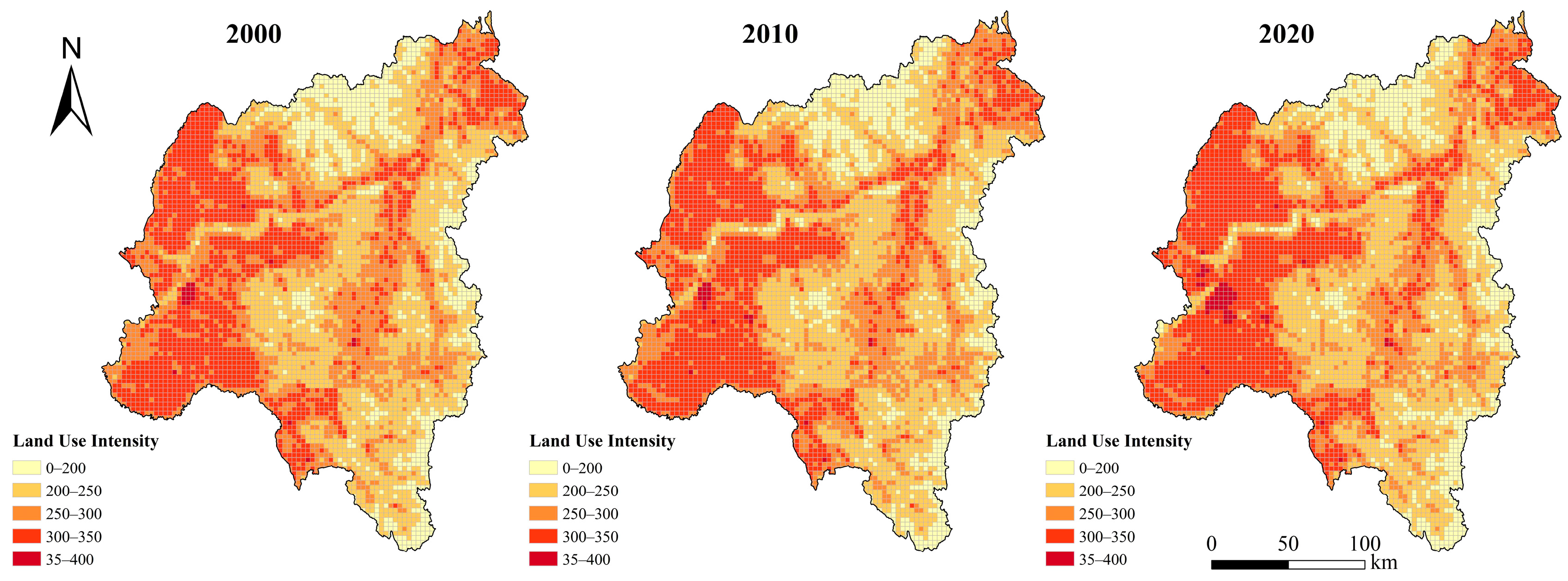
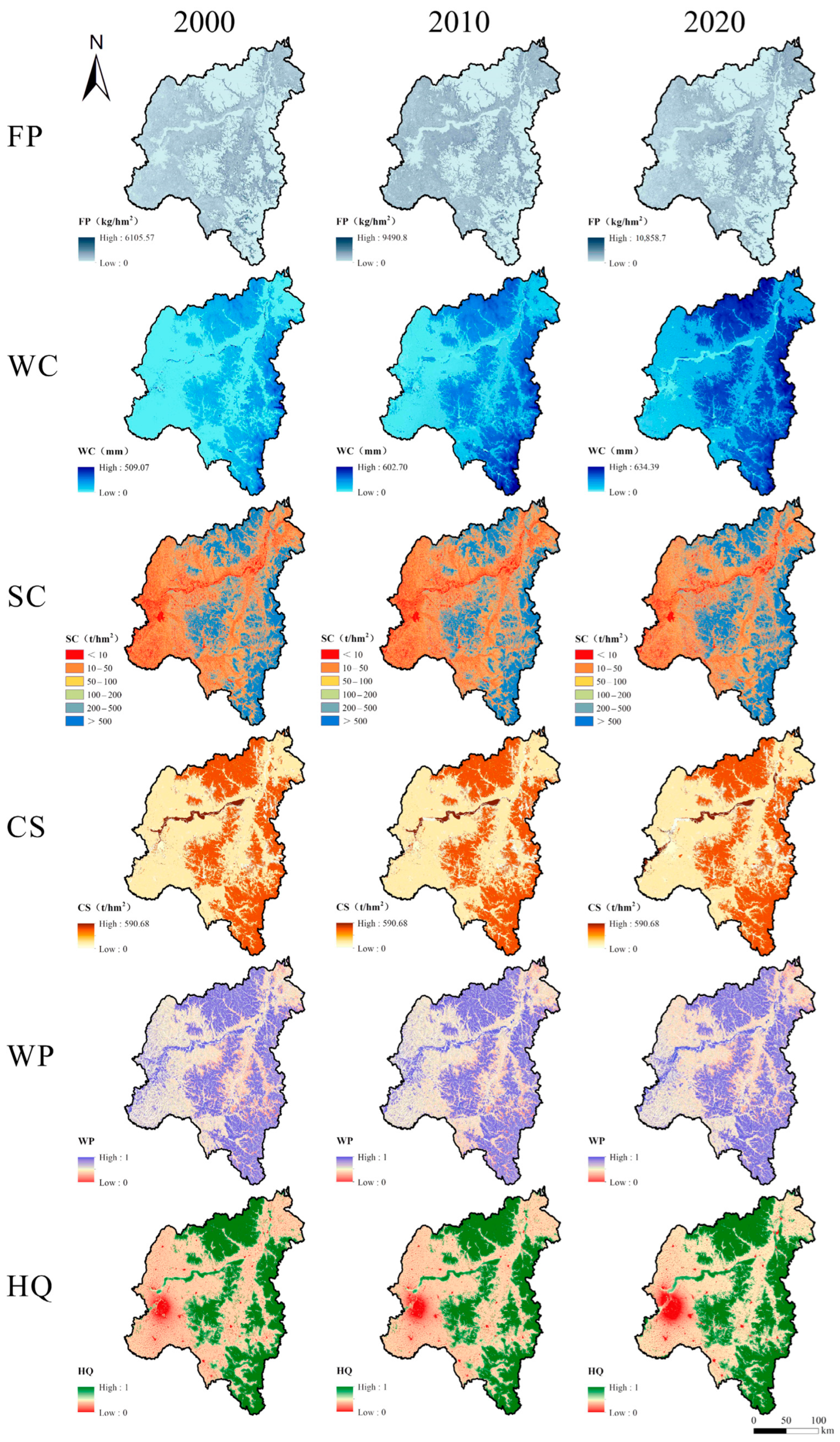
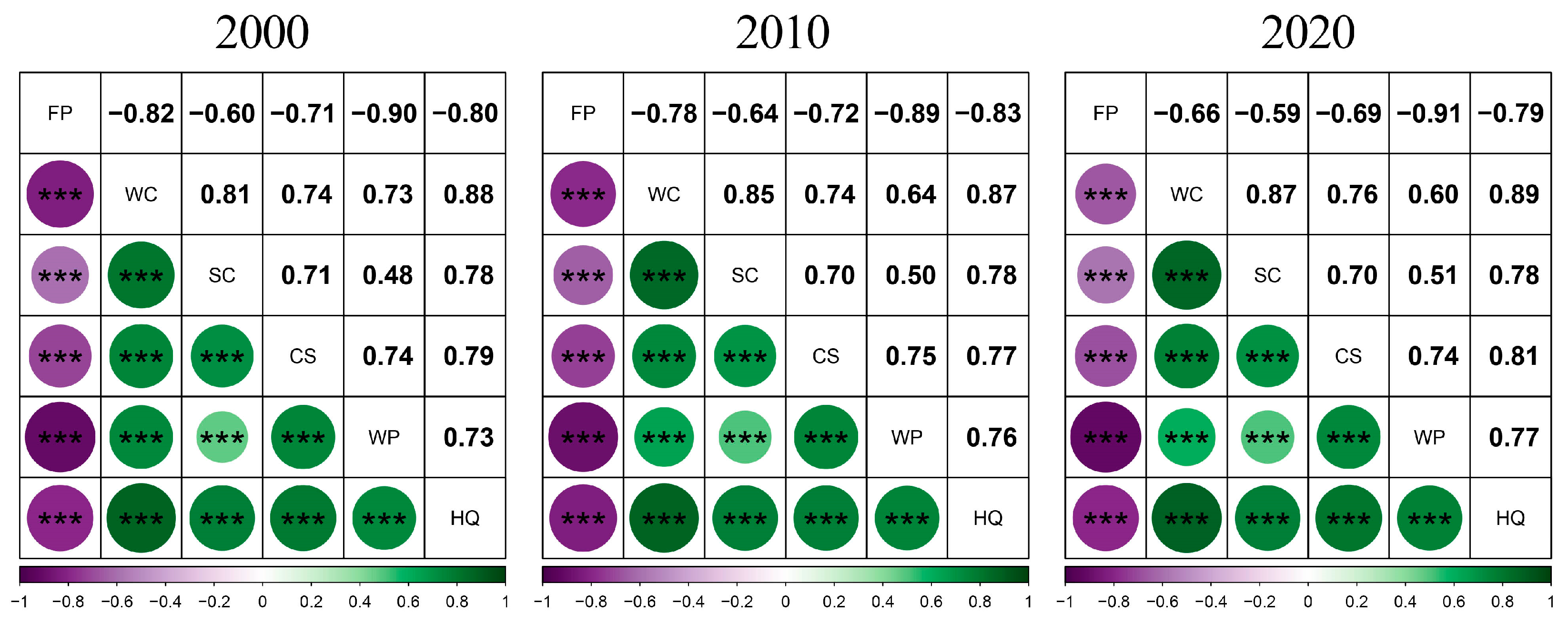
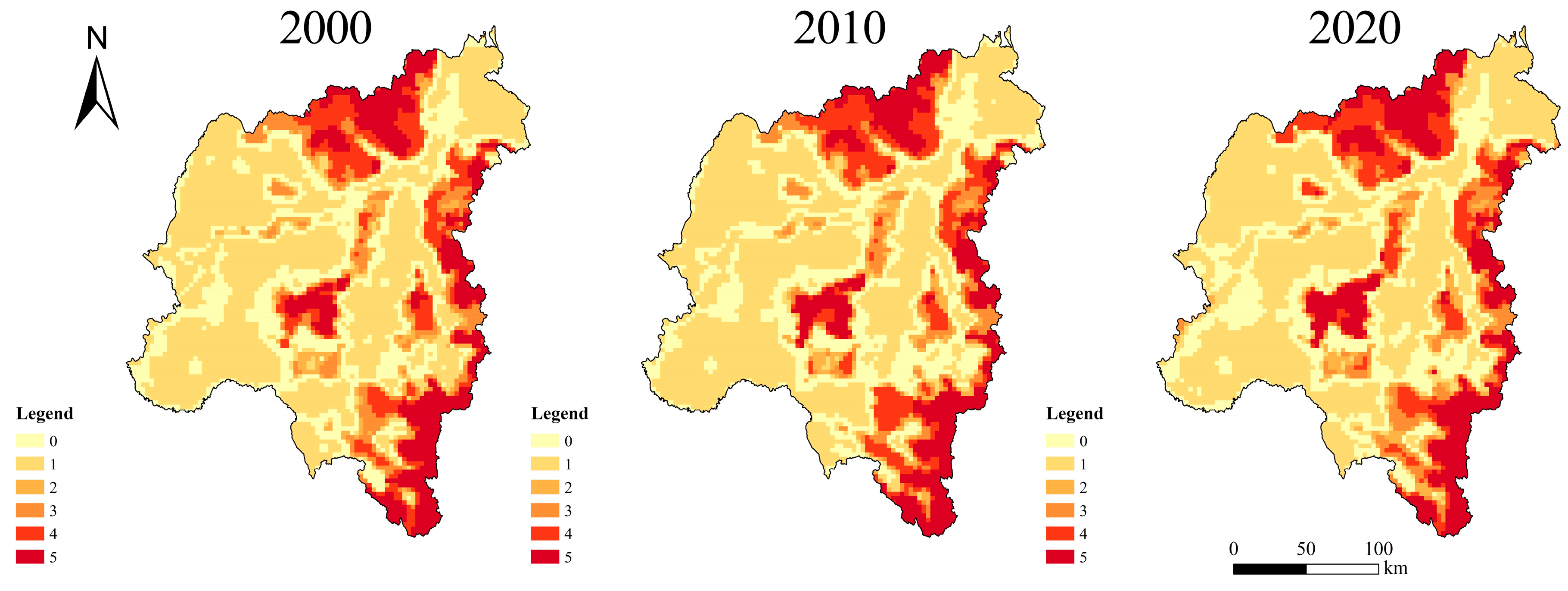
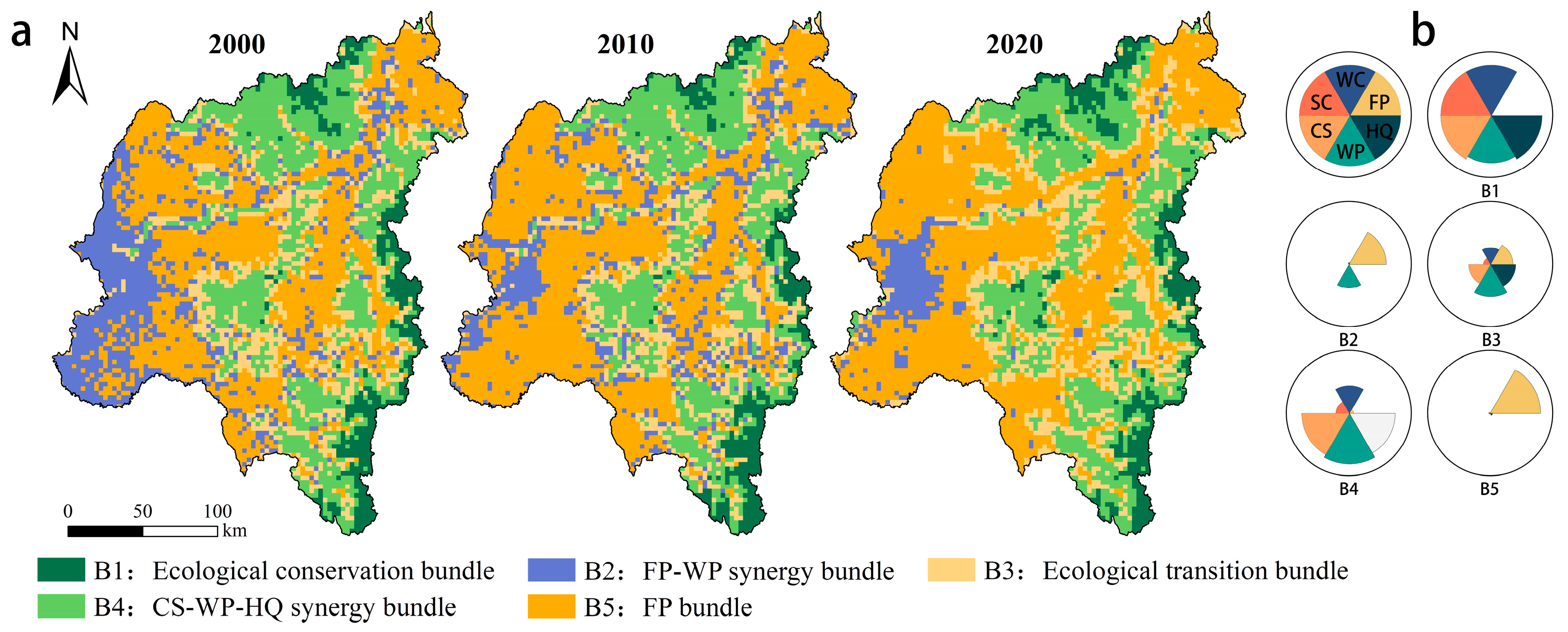
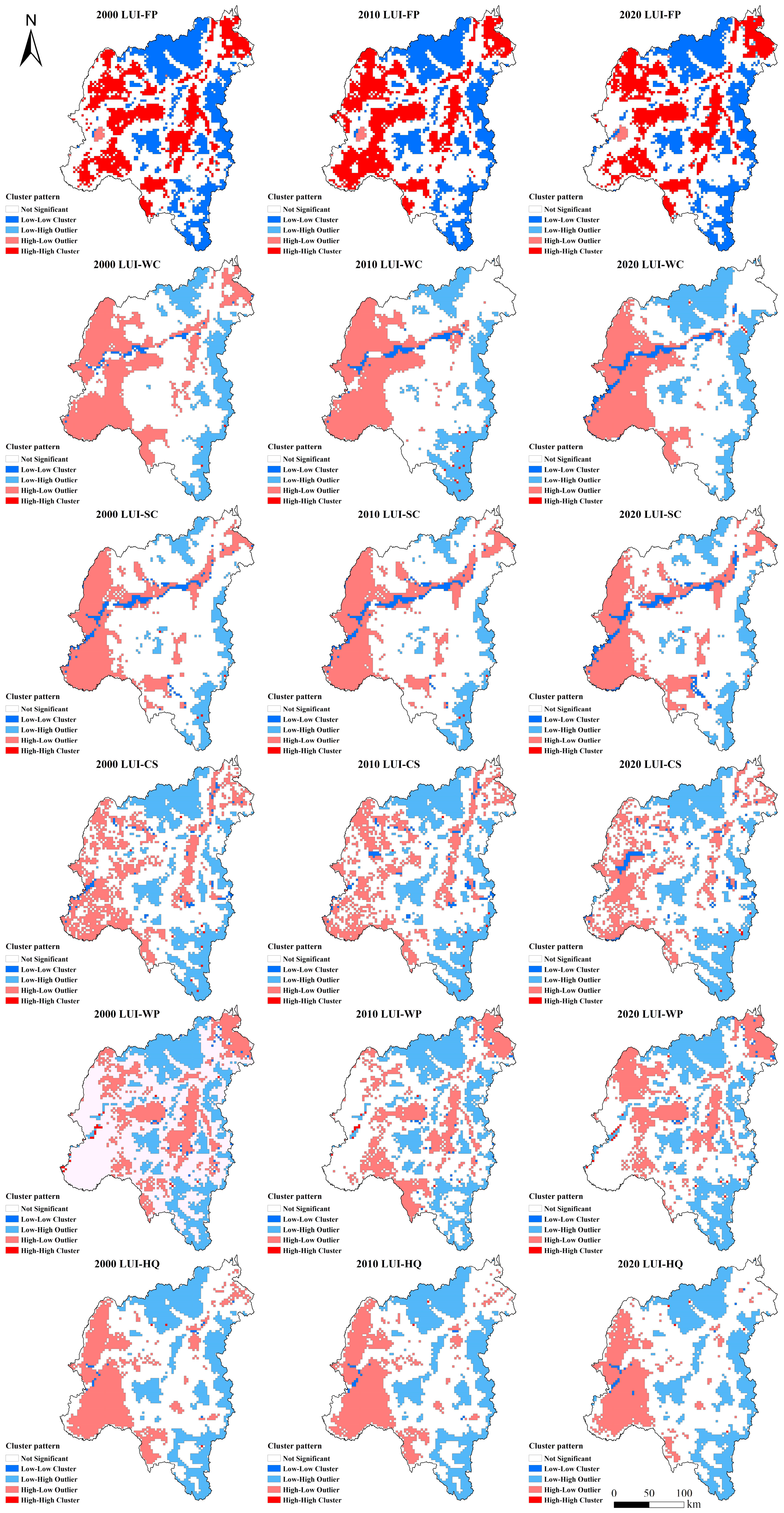
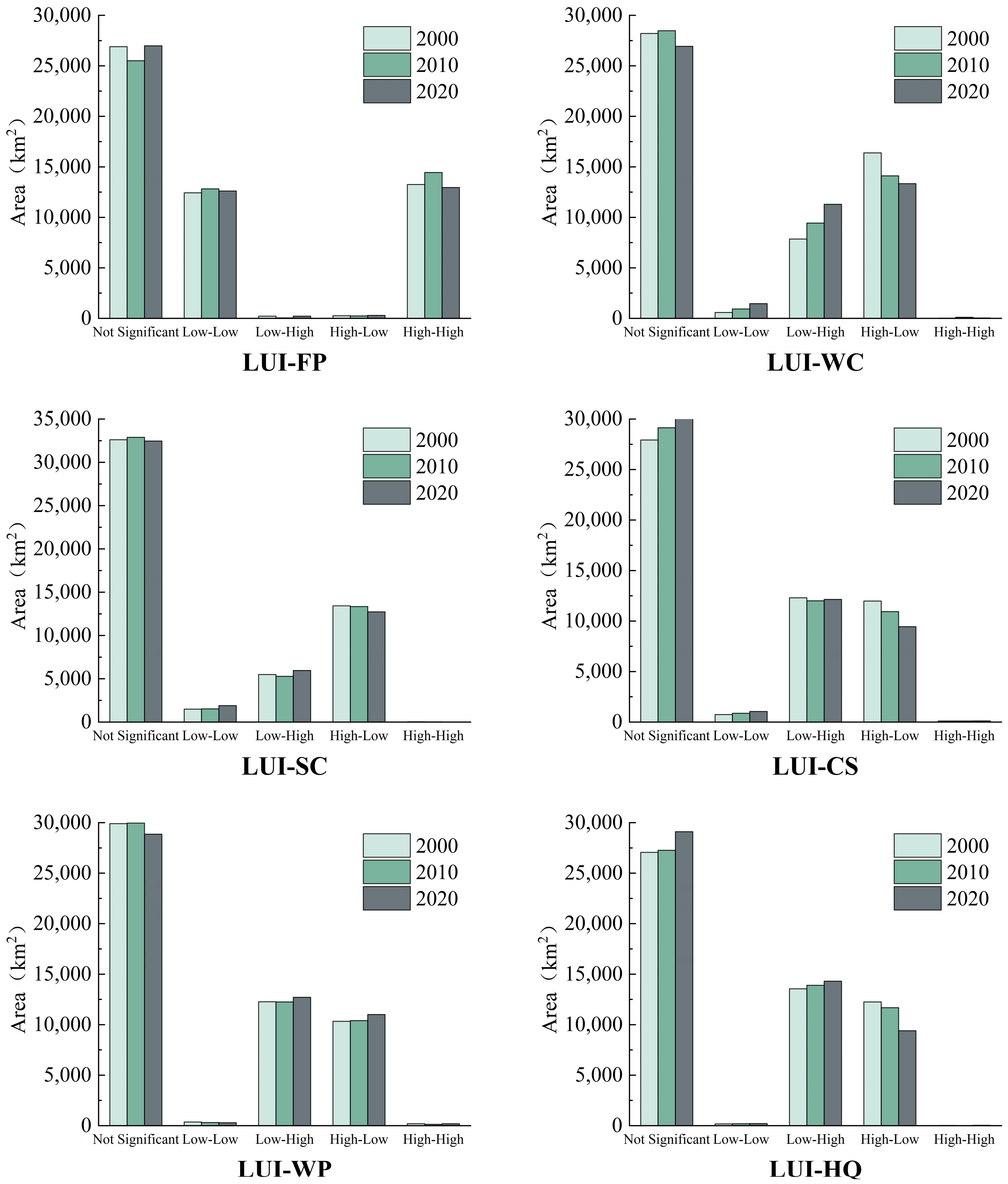
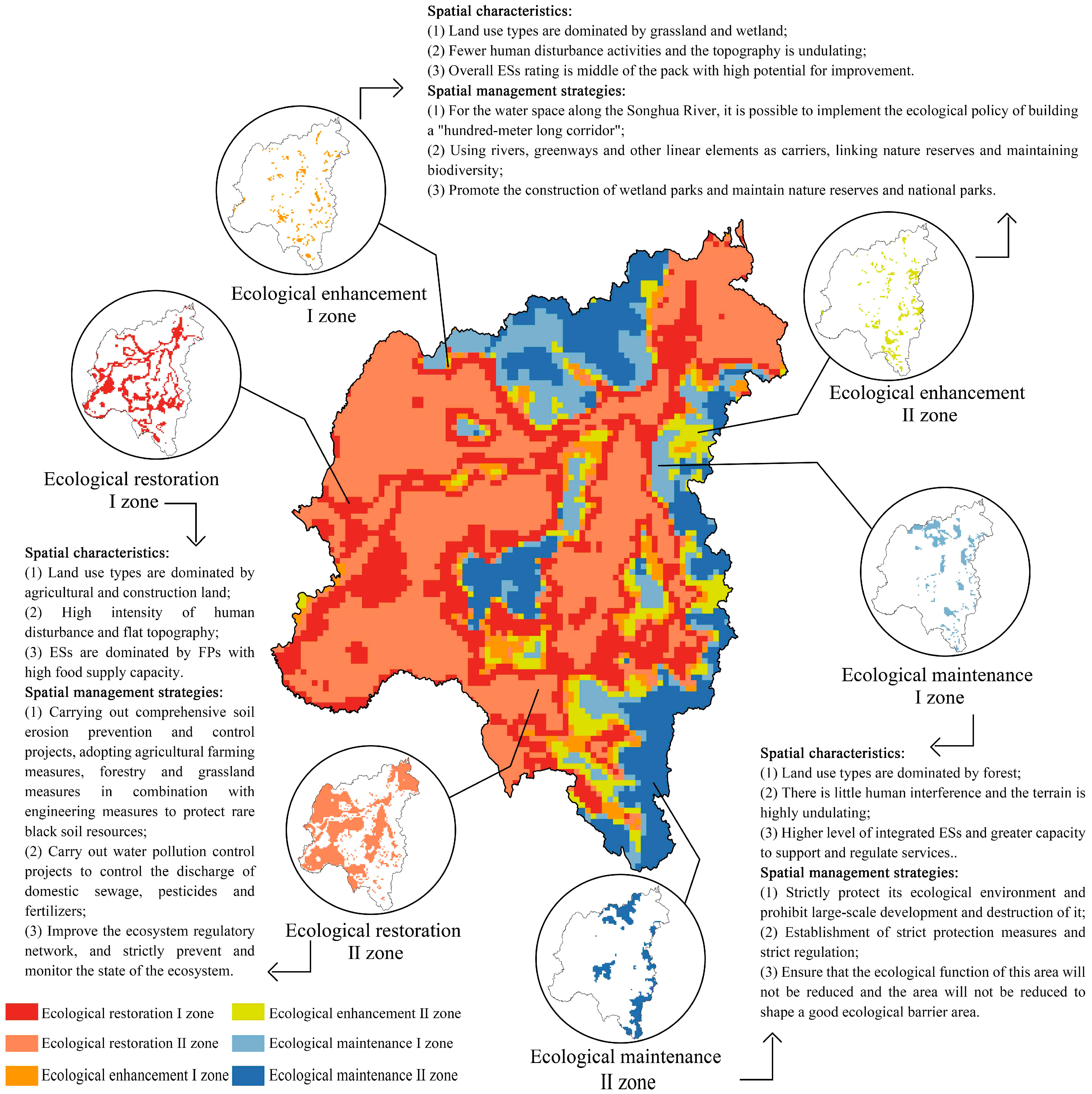
| Data | Type | Data Source | Spatial Resolution | Accessed Date |
|---|---|---|---|---|
| Land use/land cover | Raster | GlobeLand30 (https://www.webmap.cn/commres.do?method=globeIndex) | 30 m × 30 m | 15 October 2022 |
| Annual average precipitation | Raster | National Earth System Science Data Center, National Science and Technology Infrastructure of China (http://www.geodata.cn) | 1 km × 1 km | 15 October 2022 |
| Reference evapotranspiration | Raster | National Earth System Science Data Center, National Science and Technology Infrastructure of China (http://www.geodata.cn) | 1 km × 1 km | 15 October 2022 |
| Digital Elevation Model (DEM) | Raster | Geospatial data cloud (http://www.gscloud.cn) | 30 m × 30 m | 6 December 2022 |
| NPP | Raster | U.S. Geological Survey (USGS) (https://lpdaac.usgs.gov/product_search/?view=list) | 500 m × 500 m | 8 March 2023 |
| Grain production | .txt file | Harbin Statistical Yearbook (https://www.harbin.gov.cn/haerbin/c104482/list_navlist.shtml) | — | 8 March 2023 |
| Soil data | Raster | The dataset is provided by National Cryosphere Desert Data Center (http://www.ncdc.ac.cn) | 1 km × 1 km | 15 October 2022 |
| Threat | Max Distance/km | Weight | Attenuation Type |
|---|---|---|---|
| Agricultural land | 4 | 0.5 | Linear |
| Construction land | 8 | 1 | Exponential |
| Bare land | 6 | 0.6 | Linear |
| Name | Habitat Suitability | Sensitivity | ||
|---|---|---|---|---|
| Agricultural Land | Construction Land | Bare Land | ||
| Agricultural land | 0.6 | 0 | 0.9 | 0.5 |
| Woodland | 1 | 0.5 | 0.8 | 0.2 |
| Grassland | 1 | 0.2 | 0.5 | 0.3 |
| Wetland | 1 | 0.5 | 0.8 | 0.2 |
| Water body | 0.9 | 0.4 | 0.6 | 0.5 |
| Construction land | 0 | 0 | 0 | 0.1 |
| Bare land | 0.3 | 0.1 | 0.3 | 0 |
| Years | Types | Agriculture Land | Forest | Grassland | Wetland | Water Body | Construction Land | Bare Land | Total |
|---|---|---|---|---|---|---|---|---|---|
| 2000–2010 | Agriculture land | 26,010.70 | 311.72 | 468.93 | 6.78 | 56.47 | 273.00 | 0.10 | 27,127.68 |
| Forest | 224.17 | 17,868.14 | 694.83 | 3.54 | 39.44 | 11.52 | 0 | 18,841.63 | |
| Grassland | 350.91 | 445.27 | 3112.82 | 32.41 | 85.51 | 99.83 | 0.01 | 4126.76 | |
| Wetland | 31.91 | 19.16 | 70.33 | 691.89 | 32.61 | 0.24 | 0 | 846.14 | |
| Water body | 71.60 | 22.95 | 26.88 | 11.16 | 473.16 | 0.76 | 0 | 606.52 | |
| Construction land | 266.69 | 14.65 | 57.64 | 0.07 | 1.53 | 1168.67 | 0 | 1509.26 | |
| Bare land | 0.0036 | 0.0009 | 0.01 | 0 | 0 | 0 | 0.02 | 0.03 | |
| 2010–2020 | Agriculture land | 24,972.92 | 644.56 | 405.91 | 161.12 | 91.81 | 669.29 | 11.58 | 26,957.19 |
| Forest | 286.71 | 17,397.62 | 872.70 | 30.97 | 35.96 | 59.77 | 0.85 | 18,684.58 | |
| Grassland | 321.87 | 950.90 | 2884.56 | 94.29 | 82.25 | 94.40 | 3.72 | 4431.98 | |
| Wetland | 14.33 | 0.16 | 5.90 | 594.66 | 126.44 | 4.43 | 0 | 745.93 | |
| Water body | 47.19 | 20.32 | 12.54 | 24.18 | 582.59 | 2.36 | 0.01 | 689.18 | |
| Construction land | 167.61 | 4.44 | 13.13 | 0.83 | 2.13 | 1365.17 | 0.72 | 1554.03 | |
| Bare land | 0.02 | 0.0045 | 0.05 | 0 | 0 | 0 | 0.06 | 0.12 | |
| 2000–2020 | Agriculture land | 24,619.39 | 796.67 | 651.25 | 159.99 | 115.99 | 772.89 | 11.51 | 27,127.68 |
| Forest | 353.66 | 17,341.01 | 999.92 | 30.86 | 56.13 | 59.22 | 0.83 | 18,841.63 | |
| Grassland | 463.11 | 832.77 | 2465.07 | 117.01 | 100.42 | 144.65 | 3.74 | 4126.76 | |
| Wetland | 42.27 | 13.27 | 22.00 | 576.09 | 187.45 | 5.07 | 0 | 846.14 | |
| Water body | 81.19 | 20.48 | 20.71 | 21.36 | 458.24 | 4.47 | 0.07 | 606.52 | |
| Construction land | 249.84 | 11.10 | 35.41 | 0.58 | 2.45 | 1209.12 | 0.76 | 1509.26 | |
| Bare land | 0.0027 | 0 | 0.01 | 0 | 0 | 0 | 0.02 | 0.03 | |
| Total | 25,809.46 | 19,015.30 | 4194.37 | 905.89 | 920.68 | 2195.42 | 16.93 | 53,058.02 |
| Hotspot Value | Area (km2) | Share (%) | ||||
|---|---|---|---|---|---|---|
| 2000 | 2010 | 2020 | 2000 | 2010 | 2020 | |
| 0 | 11,797.40 | 11,929.00 | 11,872.40 | 22.23 | 22.48 | 22.37 |
| 1 | 23,427.40 | 22,951.00 | 22,504.70 | 44.14 | 43.24 | 42.40 |
| 2 | 2289.40 | 2484.19 | 2428.52 | 4.31 | 4.68 | 4.58 |
| 3 | 3884.24 | 3422.17 | 3460.84 | 7.32 | 6.45 | 6.52 |
| 4 | 4855.82 | 5377.83 | 5182.12 | 9.15 | 10.13 | 9.76 |
| 5 | 6820.19 | 6910.29 | 7625.89 | 12.85 | 13.02 | 14.37 |
| Years | LUI-FP | LUI-WC | LUI-SC | LUI-CS | LUI-WP | LUI-HQ |
|---|---|---|---|---|---|---|
| 2000 | 0.758 | −0.763 | −0.587 | −0.750 | −0.661 | −0.845 |
| 2010 | 0.777 | −0.780 | −0.571 | −0.742 | −0.669 | −0.847 |
| 2020 | 0.728 | −0.765 | −0.586 | −0.718 | −0.683 | −0.847 |
Disclaimer/Publisher’s Note: The statements, opinions and data contained in all publications are solely those of the individual author(s) and contributor(s) and not of MDPI and/or the editor(s). MDPI and/or the editor(s) disclaim responsibility for any injury to people or property resulting from any ideas, methods, instructions or products referred to in the content. |
© 2023 by the authors. Licensee MDPI, Basel, Switzerland. This article is an open access article distributed under the terms and conditions of the Creative Commons Attribution (CC BY) license (https://creativecommons.org/licenses/by/4.0/).
Share and Cite
Qi, Y.; Wang, R.; Shen, P.; Ren, S.; Hu, Y. Impacts of Land Use Intensity on Ecosystem Services: A Case Study in Harbin City, China. Sustainability 2023, 15, 14877. https://doi.org/10.3390/su152014877
Qi Y, Wang R, Shen P, Ren S, Hu Y. Impacts of Land Use Intensity on Ecosystem Services: A Case Study in Harbin City, China. Sustainability. 2023; 15(20):14877. https://doi.org/10.3390/su152014877
Chicago/Turabian StyleQi, Yuxin, Ruoyu Wang, Peixin Shen, Shu Ren, and Yuandong Hu. 2023. "Impacts of Land Use Intensity on Ecosystem Services: A Case Study in Harbin City, China" Sustainability 15, no. 20: 14877. https://doi.org/10.3390/su152014877
APA StyleQi, Y., Wang, R., Shen, P., Ren, S., & Hu, Y. (2023). Impacts of Land Use Intensity on Ecosystem Services: A Case Study in Harbin City, China. Sustainability, 15(20), 14877. https://doi.org/10.3390/su152014877






